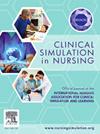Acceptance and effectiveness of high-fidelity simulation in nursing education: Application of the Technology Acceptance Model (TAM)
IF 2.5
3区 医学
Q1 NURSING
引用次数: 0
Abstract
Background
High-fidelity simulation (HFS) is a cornerstone methodology in nursing education, enhancing clinical competence, patient safety, and decision-making skills.
Aim
To evaluate nursing students’ acceptance and perceived effectiveness of HFS at a private university in Colombia, applying the Technology Acceptance Model (TAM).
Method
A descriptive cross-sectional study was conducted with 115 nursing students using the TAM questionnaire. Data were analyzed through descriptive statistics and confirmatory factor analysis in RStudio. Methodological rigor was ensured by adhering to STROBE guidelines.
Findings
Students reported high perceived usefulness (median = 4.8) and ease of use (median = 4.2). Strong correlations were observed between attitude (r = 0.67) and intention to use (r = 0.69), particularly among advanced-semester students. Acceptance increased with greater exposure to complex simulations.
Discussion
The findings validate the applicability of the TAM in this context and underscore the influence of familiarity and perceived usefulness in shaping positive attitudes toward HFS.
Conclusion
HFS is well-accepted by nursing students and should be progressively integrated into the curriculum, beginning in early semesters, supported by institutional infrastructure and faculty preparedness.
高保真仿真在护理教育中的接受度与有效性:技术接受模型(TAM)的应用
高保真模拟(HFS)是护理教育的基础方法,可提高临床能力、患者安全和决策技能。目的应用技术接受模型(TAM)评价哥伦比亚一所私立大学护理专业学生对HFS的接受程度和感知效果。方法采用TAM问卷对115名护生进行描述性横断面研究。在RStudio中通过描述性统计和验证性因子分析对数据进行分析。通过遵守STROBE指南,确保了方法的严谨性。学生报告了较高的感知有用性(中位数= 4.8)和易用性(中位数= 4.2)。在态度(r = 0.67)和使用意图(r = 0.69)之间观察到很强的相关性,特别是在高年级学生中。接受度随着复杂模拟的增加而增加。研究结果验证了TAM在这种情况下的适用性,并强调了熟悉度和感知有用性在形成对HFS的积极态度方面的影响。结论hfs已为护生所接受,应从早期学期开始逐步纳入课程,并辅以机构基础设施和师资准备。
本文章由计算机程序翻译,如有差异,请以英文原文为准。
求助全文
约1分钟内获得全文
求助全文
来源期刊

Clinical Simulation in Nursing
NURSING-
CiteScore
5.50
自引率
15.40%
发文量
107
期刊介绍:
Clinical Simulation in Nursing is an international, peer reviewed journal published online monthly. Clinical Simulation in Nursing is the official journal of the International Nursing Association for Clinical Simulation & Learning (INACSL) and reflects its mission to advance the science of healthcare simulation.
We will review and accept articles from other health provider disciplines, if they are determined to be of interest to our readership. The journal accepts manuscripts meeting one or more of the following criteria:
Research articles and literature reviews (e.g. systematic, scoping, umbrella, integrative, etc.) about simulation
Innovative teaching/learning strategies using simulation
Articles updating guidelines, regulations, and legislative policies that impact simulation
Leadership for simulation
Simulation operations
Clinical and academic uses of simulation.
 求助内容:
求助内容: 应助结果提醒方式:
应助结果提醒方式:


